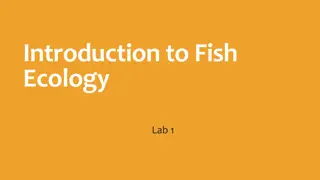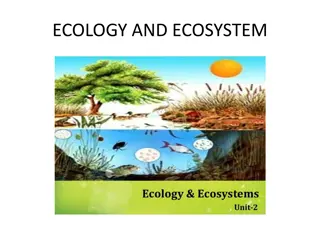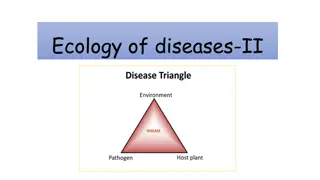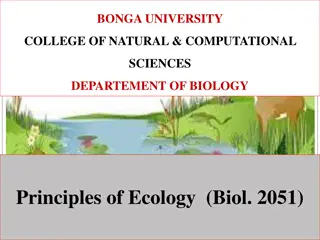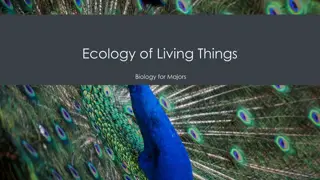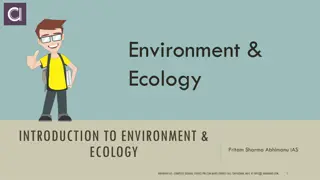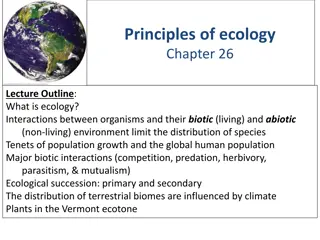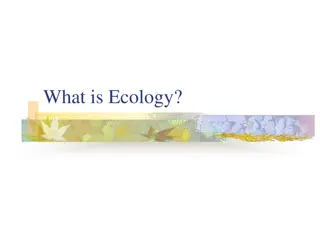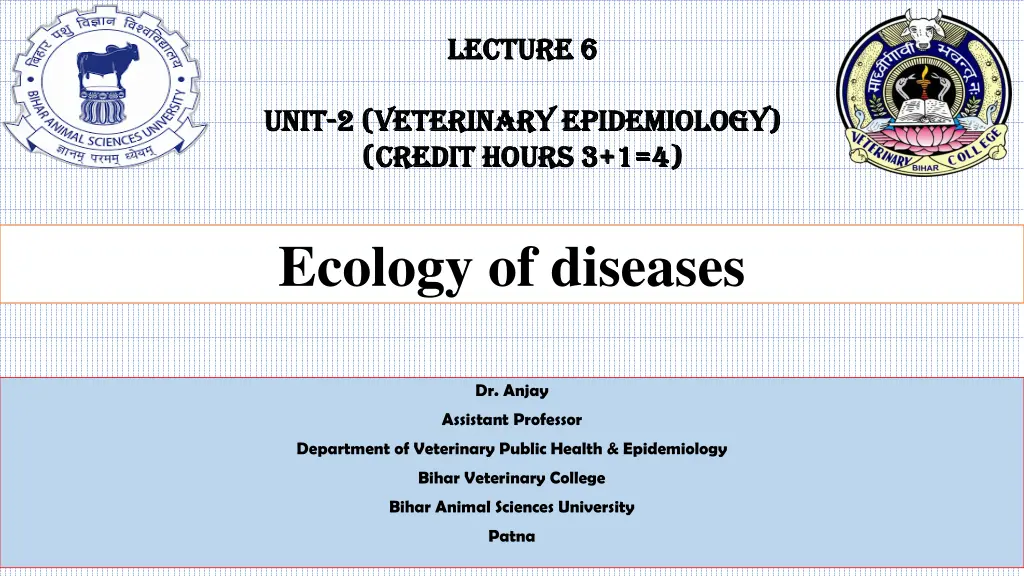
Understanding Ecology in Veterinary Epidemiology
Explore the importance of ecology in veterinary epidemiology with a focus on disease ecology, basic ecological concepts, factors influencing disease spread, and the niche concept. Enhance your knowledge of how ecology plays a crucial role in understanding disease transmission and control strategies.
Uploaded on | 3 Views
Download Presentation

Please find below an Image/Link to download the presentation.
The content on the website is provided AS IS for your information and personal use only. It may not be sold, licensed, or shared on other websites without obtaining consent from the author. If you encounter any issues during the download, it is possible that the publisher has removed the file from their server.
You are allowed to download the files provided on this website for personal or commercial use, subject to the condition that they are used lawfully. All files are the property of their respective owners.
The content on the website is provided AS IS for your information and personal use only. It may not be sold, licensed, or shared on other websites without obtaining consent from the author.
E N D
Presentation Transcript
Lecture 6 Lecture 6 UNIT UNIT- -2 (VETERINARY EPIDEMIOLOGY) 2 (VETERINARY EPIDEMIOLOGY) (Credit Hours 3+1=4) (Credit Hours 3+1=4) Ecology of diseases Dr. Anjay Assistant Professor Department of Veterinary Public Health & Epidemiology Bihar Veterinary College Bihar Animal Sciences University Patna
What is ecology?? Ecology (Greek: oikos= house; logo- = discoursing) The study of animals and plants in relation to their habits and habitation (habitat) is ecology The study of a disease's ecology (also termed its natural history) is frequently a part of epidemiological investigations
Objectives of ecology 1. An increase in the understanding of the pathogenesis, maintenance and, for infectious agents, transmission of disease 2. The use of knowledge of a disease's ecology to predict when and where a disease may occur, to enable the development of suitable control techniques
Basic ecological concepts Factors: Determine the occurrence of disease Size of animal populations Availability of food, Availability of mates & the species' Breeding potential Distribution of animal populations Distribution of suitable food Distribution of suitable food Distribution of suitable food The balance of nature Control of population size by competition Dispersal Predation Vegetation zone Tundra Savannah Desert Regulation of population size Home range Biomes Territoriality Social dominance
Factors effecting the disease spread 1. The distribution of host 2. Home range: if home range increase: increase disease 3. Other behavioral activities of host: ex. Rabies in foxes in Europe Dump rabies: solitary existence Furious rabies: approach other animals
The Niche Competition: Intra species competition Inter species competition Coexistence of two strongly competing species is impossible This led to the principle of competitive exclusion: that competition will exclude all but one Species from a particular position defined by an animal's feeding habits, physiology, mechanical abilities and behavior. This position is an animal s niche. Competitive exclusion has been used as a means of disease control (Ex. The snail Biompholaria glabrata (I/H of Schistosomiasis) Marisa cornuarietis (more competitive snail) One Species one Niche
The Niche Example of niche related diseases: 1. Louse infestation: Host specific so avoid competition 2. Intracellular parasitism: Occupy niche in cell All viruses Some bacteria (Mycobacterium, Rickettsiae, Brucella spp.) Some protozoa (Babesia spp.)
Epidemiological interference One type of respiratory adenovirus prevents infection with other types, even though the latter are common in surrounding community 1. Can effect the time of occurrence of disease: Ex. altering age specific incidence rate (Human respiratory infections) 2. Alters the rate of natural immunization: Ex. Interference by other enterovirus delays natural poliovirus immunization in man
The relationships between the different types of plant and animals Food chain: Simplistic view of the relationship between an animal and its food
The relationships between the different types of plant and animals Food webs and size of animals:
Ecosystem Animals and plants that occupy them, and by their physical and climatic features. This unique interacting complex is called an ecosystem (An association of a biocenosis with the physical environment including soil or An association of living beings & their habitat). Types: According to their origin Autochthonous ecosystems Anthropurgic ecosystems Synanthropic ecosystems
Ecosystem Autochthonous ecosystems Greek word: autos: itself chthon: the earth or the land ous: deriving Ex. Tropical rain forest, desert Anthropurgic ecosystems Greek word: anthropos: man rooterg: to creat, to produce Ex. Cultivated Pasteur & town Synanthropic ecosystems Greek word: syn: along with anthropos: man Ex. An example is a rubbish tip, harboring a variety ofvermin (Leptosirosis)
Ecosystem Biotope: A biotope is the smallest spatial unit providing uniform conditions for life An organism's biotope therefore describes its location A biotope can vary in size Ex. Caeca of a chicken for coccidia, an area of poorly drained land for Fasciola hepatica infection of cattle Different from niche which describes the functional position of an organism Biocenosis A biocenosis is the collection of living organisms in a biotope The organisms include plants, animals and the microorganisms in the biotope Biotic community: Large biocenosis. Major biotic communities are biomes.
Ecosystem An ecological climax An ecological climax traditionally is said to have occurred when plants, animals, microbes, soil and macroclimate have evolved to a stable, balanced relationship Infection is there & stable too: Endemic infection The balance between host and parasite: In-apparent infection If balance break: Epidemic infection Ex. Bluetongue, in-apperent infection in indigenous sheep in South Africa due to ecological climax. The importation of exotic sheep (European breed) represented a disturbance of the stable climax
Ecosystem Ecological interfaces An ecological interface is a junction of two ecosystems Infectious diseases can be transmitted across these interfaces Ex: Transmission of yellow fever The virus is maintained in apes in Africa in an autochthonous forest ecosystem Virgin forest cycle: Aedes africanus: transmits the virus between apes Plantation cycle: A. simpsoni: bridges the interface between the autochthonous forest ecosystem & the anthropurgic cultivated savannahs. Town cycle:A. aegypti: Between man.
Ecosystem Ecological mosaics An ecological mosaic is a modified patch of vegetation, created by man, within a biome that has reached a climax Infection may spread from wild animals to man Ex. The helminth infection loiasis is transmitted by arthropods between man, living in small forest clearing, and canopy-dwelling monkeys. Ex. Clearing of the forest canopy encourages a close cover of weeds on the ground, creating conditions that are favourable for the incursion of field rats with mites infected with scrub typhus, which form mites infected with scrub typhus, which form mite islands and the resulting local areas of endemic scrub typhus
Landscape epidemiology The study of diseases in relation to the ecosystems in which they are found is landscape epidemiology Similar terms: Medical ecology Horizontal epidemiology Medical geography Investigations are: qualitative in nature Involves the study of ecological factors that effects the occurrence, maintenance, and transmission of disease
Landscape epidemiology Nidality: foci were natural homes of these diseases & were called nidi (Latin: nidus = nest) Many arthropod transmitted infections present in the steppes were also limited to distinct geographical areas The presence of a nidus depends on its limitation to particular ecosystem An area that has ecological, social, & environmental conditions that can support a disease is a nosogenic territory Nosoarea: is a nosogenic territory in which a particular disease is present
Landscape epidemiology Objectives: Prediction about the occurrence of disease Facilitates the development of appropriate control strategies Ex. Leptospirosis Tularemia Kyasanur Forest disease
THANKS FOR KIND ATTENTION




